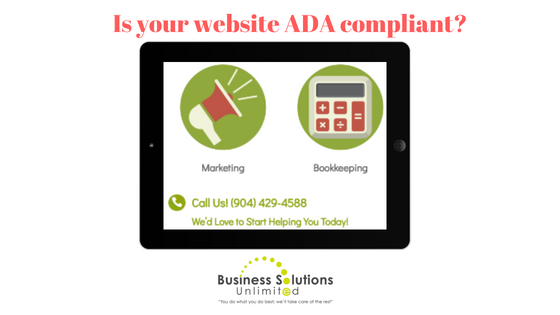In 2017, the grocery store chain, Winn-Dixie, lost a lawsuit alleging that their website violated the Americans with Disabilities Act (ADA).
Specifically, the grocer’s website was found not accessible to a blind plaintiff according to Title III of the ADA mandates.
Winn-Dixie was ordered to pony up $250,000 to conform their website to Web Content Accessibility Guidelines (WCAG) 2.0AA. Plus, the Plaintiff’s Attorneys were going to pursue legal fees from the grocer.
Website accessibility lawsuits against businesses surged in 2017. While these ADA Title III federal lawsuits occurred nationwide, New York and Florida businesses took the brunt of the legal action:
- New York with 335 lawsuits
- Florida with 325 lawsuits
Below, we’ll explore what ADA compliance means to a business’ website and suggested steps to remediate the site. However, keep in mind this article is not legal advice. It’s an effort to make you aware of a potential legal (and financial) issue that’s impacting businesses across the county.
What is ADA Compliance and How Does it Impact Your Website?
Title III of the ADA legally directs all businesses open to the public to remove access barriers that would hinder a disabled person from enjoying the business’ goods and services.
You’ll find the result of ADA compliance in the disabled parking spots, service counter heights, and ramps for wheelchair-bound individuals.
In recent years, ADA compliance attention has migrated from a business’ physical presence to their digital presence.
Courts have ruled that any website offering goods and services be considered a place of public accommodation. Regardless if the business has a physical presence or not.
How do courts determine if a website is accessible? They’ve used a set of guidelines that determine if a website is ADA compliant: Web Content Accessibility Guidelines (WCAG).
What is WCAG?
It’s globally recognized guidelines compiled by the World Wide Web Consortium that have set the technical standards for website accessibility.
Accessibility guidelines are divided into four main principals:
- Perceivable
- Operable
- Understandable
- Robust
Criteria for accessibility is provided based on:
Level A: Criteria affecting the largest number of potential users—basically the minimum level of conformance.
Level AA: Satisfying Level A criteria plus deals with the largest and most common barriers for disabled users.
Level AAA: The highest and most complex challenges of website accessibility.
Courts have focused on Level AA for their rulings.
Accessibility guidelines for websites concern at a minimum:
Page structure: Making sure content uses a semantic structure to help user’s and devices understand page hierarchy
Navigation: Provide means to easily navigate the site and web pages using a keyboard and skip navigation.
Text:
- Allowing assistive technologies to read the page, for example, ability to scale text 200%.
- Make sure text clearly communicates instructions in a way that the disabled can understand
- Text instructions in forms should be easily understood
Links: Make sure links to make sense when read out of context. For example, instead of “read more” or “click here” be specific like “read more about ADA compliance here” or “Click here to download this guide.”
Images: Make sure that each image on your page uses alternative (alt) text to accurately describe it. If you use images with text, be sure the alt text communicates the text.
Videos and Audio: Provide captioning and transcripts for videos appearing on your site.
More About the Lawsuits
As mentioned above, 2017 saw a surge of lawsuits regarding website accessibility. While Winn-Dixie had a large financial impact, small businesses were impacted as well.
In California, Whisper Lounge Restaurant was ordered to make its website comply with WCAG 2.0 AA. Also, the court ordered the restaurant to pay $4,000 in statutory damages.
For most small businesses, the legal fees defending a lawsuit and paying damages could be costly.
In 2018, the ADA Education and Reform Act was passed in the US House of Representatives that could offer some relief from frivolous lawsuits—but businesses should still be wary.
Demand letters from law firms can still be sent to businesses found in violation of ADA compliance. If the business does not respond within 60 days that they are correcting the problem, a lawsuit can be filed.
It might be prudent for businesses to be proactive and start the process of making their website ADA compliant. That way, if they do receive a letter, they can show their progress to remediate the issue and, hopefully, negate any potential legal action down the road.
Do You Need a New Site or Can You Modify Your Current One to make it ADA Compliant?
The majority of sites developed with current technologies shouldn’t have many challenges in updating their site. However, in some cases, it will take a team of web developers and designers plus content creators to ensure your site meets the Level AA guidelines.
If you have an older site, a new site might be easier to make compliant.
An accessibility audit might be necessary to determine your specific website’s needs.
Reach Out for Help with a Free Consultation
We understand that businesses are busy and researching the details of ADA website compliance and coming up with a strategy can be daunting.
Give us a call at Business Solutions Unlimited, (904) 429-4588, to discuss options and see how we can help you today.

